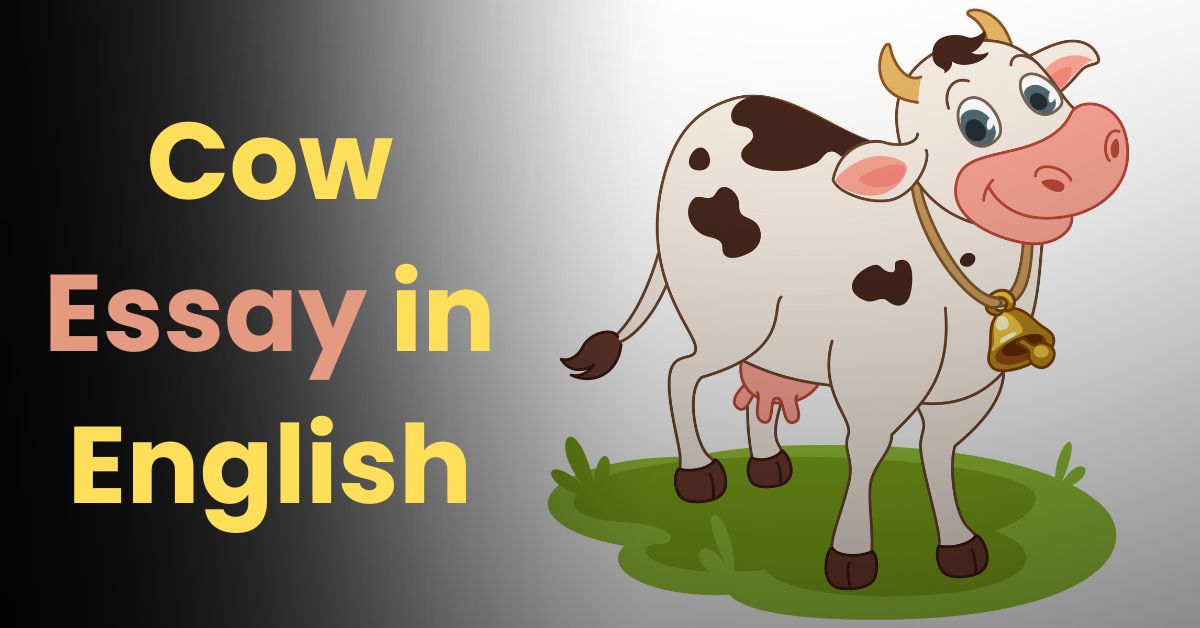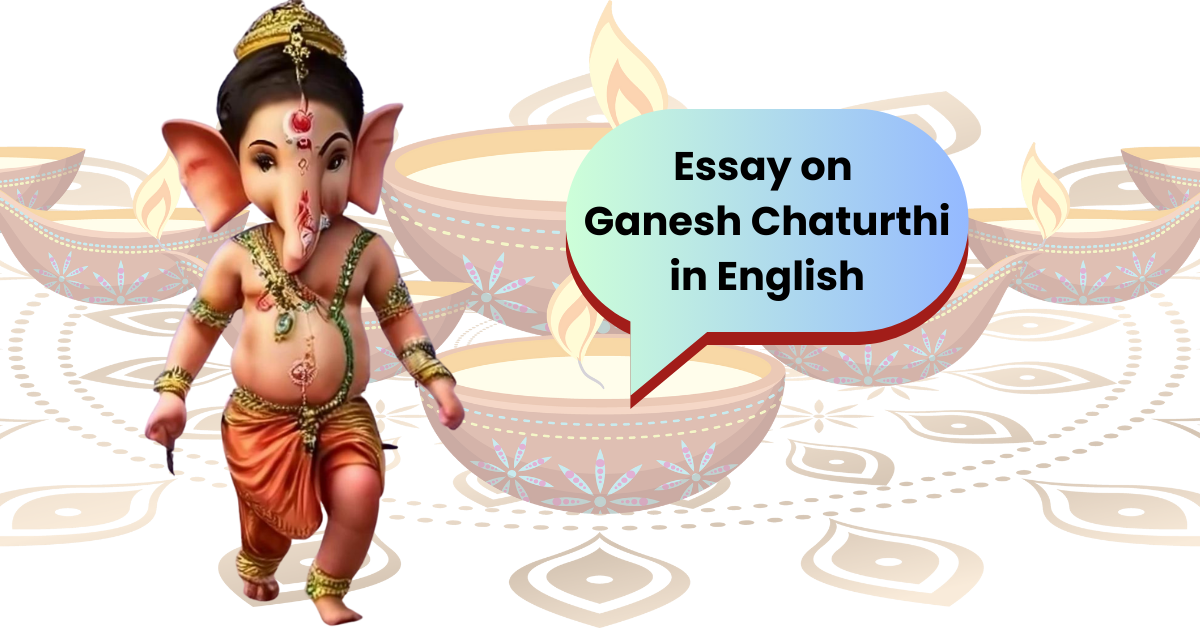Cow Essay in English: The cow is one of the most gentle and giving animals known to humankind. Revered in many cultures for its nurturing nature and invaluable contributions, the cow has earned its place in human society as more than just a domesticated animal. Its role goes far beyond providing milk and meat; it is a symbol of warmth, sustenance, and, for some, even sacredness. The cow’s quiet presence, humble demeanor, and unconditional support have endeared it to people all over the world, especially in rural communities where it plays a vital role in day-to-day life.
Cow Essay in English: Physical Characteristics of the Cow
A cow is a large, herbivorous animal with a stout body, long tail, and sturdy legs. It has a calm and gentle appearance, with expressive eyes and a nose that is typically moist. Its skin can come in various colors and patterns, including white, black, brown, or spotted, depending on the breed and environment. While cows are not fast animals, their strength and endurance are remarkable, making them suitable for tasks that require consistent, gentle labor. Most cows have small horns, though in some breeds these may be absent. Their hooves are strong and resilient, designed to help them traverse a variety of terrains.
The Cow’s Role in Agriculture and Rural Life
The cow has been a crucial partner in agriculture for centuries. In rural settings, cows serve as more than just animals to be milked; they are also sources of labor. In many parts of the world, farmers still rely on cows to plow their fields and carry loads, especially in areas where mechanized equipment is not available or affordable. Their role as ‘beasts of burden’ makes them essential for small farmers who depend on agriculture as their main source of income.
Additionally, cow dung is an invaluable resource for rural households. It is used as organic fertilizer, which enhances soil fertility and yields better crops. Cow dung also serves as a natural pesticide and is used as fuel for cooking in the form of dried dung cakes. This dual-purpose role of cows makes them a sustainable and environmentally friendly choice for rural communities worldwide.
The Nutritional Value of Milk and Dairy Products
One of the cow’s most cherished contributions is milk. Rich in calcium, protein, and essential vitamins, cow’s milk is a staple food for millions of people. From a simple glass of milk to an array of dairy products such as yogurt, cheese, and butter, cow’s milk nourishes and strengthens people of all ages. For growing children, milk is an essential source of nutrition that aids in bone development and overall health. For the elderly, it provides vital nutrients that help maintain muscle strength and bone density.
The versatility of milk has also led to the creation of diverse cuisines across the globe. In many cultures, milk-based dishes hold special significance and are often served during festivals, religious ceremonies, and family gatherings. Dairy products such as ghee, cream, and condensed milk add flavor and richness to countless dishes, making meals more enjoyable and memorable.
Cultural and Spiritual Significance
For many communities, particularly in countries like India, the cow is more than an agricultural animal; it is a symbol of spirituality and divinity. In Hindu culture, the cow is revered as a sacred animal, often associated with abundance, compassion, and motherhood. The cow’s gentle and giving nature mirrors the qualities of a mother, who nourishes and cares for her children selflessly. As a result, it is common to see cows roaming freely in parts of India, where they are respected and cared for by local communities.
This reverence is also reflected in various customs and rituals where the cow is honored and sometimes even worshipped. The cow is seen as a representation of Mother Earth, embodying patience, kindness, and resilience. In this way, the cow has become a symbol of faith and an important aspect of cultural identity for many people.
Ecological Impact and Sustainability
In today’s world, where sustainability is a growing concern, the cow’s role in maintaining an eco-friendly lifestyle is being recognized once again. Cows are considered ‘green’ animals, as they consume grass and other natural fodder, turning it into valuable resources without causing significant harm to the environment. Their ability to live off the land without requiring extensive artificial feeding makes them a low-impact option compared to many other animals used in farming.
Furthermore, the organic fertilizers produced from cow dung contribute to healthier soil, reducing the need for chemical fertilizers that can harm the environment. By supporting ecosystems and promoting a balanced environment, cows play a unique role in sustainable farming practices.
The Bond Between Humans and Cows
The relationship between humans and cows is both practical and emotional. For farmers, cows are often seen as family members rather than mere livestock. The bond between a cow and its owner can be deeply emotional, as these animals respond to kindness and care. Many farmers express a sense of responsibility and gratitude toward their cows, appreciating the daily contributions they make to the family’s livelihood.
A cow’s calm and affectionate nature has a soothing effect on people, and this emotional connection often leads to lifelong bonds. In villages, children often grow up around cows, learning to care for and respect these gentle creatures. This bond is one of mutual respect and understanding, as cows, in turn, rely on humans for food, shelter, and care.
Conclusion: Cow Essay in English
The cow’s significance goes beyond the roles it fulfills in agriculture and dairy production. It is an emblem of patience, resilience, and generosity. Whether providing essential nutrition through milk or serving as a reliable partner in farming, the cow has rightfully earned its place in human society as a loyal and nurturing animal. The cow’s contributions to our daily lives are numerous, and it stands as a silent reminder of the harmony that can exist between humans and animals.
In appreciating the cow’s quiet and humble presence, we learn the values of gratitude, responsibility, and compassion. These timeless lessons, embodied by the cow, remind us that even the simplest creatures can have the most profound impact on our lives. Through our respect and care for cows, we honor not only an animal but a way of life that values simplicity, kindness, and sustainability.
E Waste Management Essay in English: A Growing Challenge for Our Planet
FAQs: Cow Essay in English
1. Why is the cow considered a special animal in many cultures?
The cow is cherished for its gentle, nurturing nature and the endless support it provides to human communities. In many cultures, particularly in India, the cow is seen as a symbol of motherhood and abundance. With its patient and giving spirit, it provides milk that sustains families and nurtures children. This loving role endears the cow to people around the world, who see it not merely as an animal but as a cherished member of their families and communities.
2. What benefits do cows bring to rural communities?
Cows are essential to rural life in countless ways. Not only do they provide nutritious milk, but they also help with agricultural work, like plowing fields and carrying loads, especially in areas without machinery. Their dung is a valuable resource, used as organic fertilizer that improves soil quality and helps crops grow. For many families, cows are a source of both livelihood and sustenance, making them truly invaluable in rural settings.
3. How does milk from cows benefit our health?
Cow’s milk is a powerhouse of nutrition! Rich in calcium, protein, and essential vitamins, it strengthens bones, boosts immunity, and supports growth, especially in children. Drinking milk regularly contributes to a balanced diet, helping us feel strong and healthy. For the elderly, milk is a gentle source of nutrients that keeps bones and muscles resilient. Truly, every glass of milk is a gift from cows that nourishes people of all ages.
4. Why is cow dung considered so valuable in farming?
Though it may seem simple, cow dung is a natural treasure. When used as fertilizer, it enriches the soil with nutrients, making it fertile and ready for crops. Unlike synthetic chemicals, cow dung is organic and sustainable, reducing harm to the environment. In many rural areas, people also use dried dung as fuel, minimizing the need for firewood and conserving local resources. Cows, in their quiet way, help maintain a healthy environment for future generations.
5. How do people develop emotional bonds with cows?
Cows have a warm, peaceful presence that resonates deeply with people. In farming families, they are often treated with as much care as any family member, forming a bond that grows through daily interactions. Farmers and children alike feel a sense of gratitude and connection to cows, who depend on humans for care and, in return, offer so much to sustain them. This mutual understanding creates a beautiful relationship of respect, love, and appreciation.

















4 thoughts on “Cow Essay in English: Gay Par Nibandh in English”